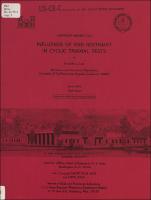Please use this identifier to cite or link to this item:
https://hdl.handle.net/11681/20552| Title: | Influence of end restraint in cyclic triaxial tests |
| Authors: | University of California, Los Angeles. Mechanics and Structures Department Lee, Kenneth L. (Kenneth Lester), 1931-1978 |
| Keywords: | Cyclic triaxial compression tests Soil strength Soil tests Soil mechanics Equipment Instruments |
| Publisher: | Soils and Pavements Laboratory (U.S.) Engineer Research and Development Center (U.S.) |
| Description: | Contract Report Abstract: Theoretical considerations concerning the effect of end restraint on the strength of soil in triaxial tests are briefly discussed herein. The theoretical aspects are supplemented by a review of all laboratory test data available to the writer. Most of the data pertain to static drained tests on sands. There are also data from static undrained tests on saturated clays. A lesser amount of previously unpublished data from the writer's files on static and cyclic loading undrained tests on saturated sands are also included. The theoretical considerations and the available data are all consistent within themselves in demonstrating and explaining the significant conclusions which follow directly from basic considerations of the behavior of soil under various loading conditions. End restraints, such as are found in most ordinary triaxial test equipment, prevent lateral strains at the ends of the specimen and thereby lead to nonuniformities and concentrations in the stresses and strains throughout the specimen. As a result, volume changes in soils which dilate strongly when sheared will be affected. If tested undrained, this will be reflected by variations in pore pressure from that associated with uniform stress and strain distributions throughout. Since most granular soils tend to dilate, especially at low effective confining pressure, this volume change tendency leads to lower pore pressures and hence stronger saturated specimens with free ends than with restrained ends, whether tested statically or under cyclic loading. For the soils from which data are available, this strength increase with frictionless versus regular end platens is about 15-20 percent for static tests and up to 25-40 percent for cyclic tests. It appears that because clay soils show less dilatant tendency when sheared than sands, the effect of end restraint is less with clays than with sands and is almost negligible for normally consolidated clay from which data are available. Although there are considerable data from static tests, the data from cyclic tests are quite limited, involving only one sand and no clays. Therefore, the conclusions above must be considered as preliminary, pending further laboratory test results with both regular and frictionless end specimens. |
| Rights: | Approved for public release; distribution is unlimited. |
| URI: | http://hdl.handle.net/11681/20552 |
| Appears in Collections: | Contract Report |
Files in This Item:
| File | Description | Size | Format | |
|---|---|---|---|---|
| CR-S-76-1.pdf | 12.11 MB | Adobe PDF |  View/Open |